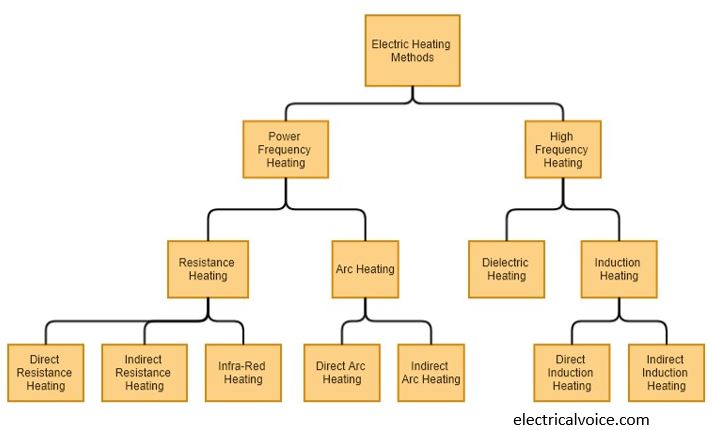Electric heating means the production of heat energy from electrical energy. This type of heating can be generated by several methods.
Classification of Electric Heating Methods
The classification of electric heating methods is shown in the following figure.

In general, Electric heating can be classified as power frequency heating and high frequency heating.
Power Frequency heating
Power frequency heating can be classified into 2 types i.e. resistance heating and arc heating.
(1) Resistance Heating
Resistance heating is based on I2R effect. It can be classified into 3 types i.e. direct resistance heating, indirect resistance heating and infra-red heating.
(a) Direct Resistance Heating
In this type of heating, electric current is passed directly through the body to be heated. Since the body has resistance, current causes heat generation in the body. Hence, it raises the body temperature.
Applications
- electrode boiler for heating water
- resistance welding
(b) Indirect Resistance Heating
In this type of heating, electric current is passed through a resistive element. The power dissipated as I2R loss is delivered to the body to be heated by convection or radiation.
Applications
- resistance ovens
- cooking
- heat treatment of metals
- immersion heaters
(c) Infra-red Heating
In this type of heating, incandescent lamp is used for heating the body. The body is heated due to electromagnetic radiations produced by the lamp.
Applications
- used for drying wet paints on an object
(2) Arc Heating
Arc heating is based on the arc formation between two electrodes causing generation of high temperature. This high temperature is responsible for heating of a body. Arc heating can be classified into 2 types i.e. direct arc heating and indirect arc heating.
(a) Direct Arc Heating
In this type of heating, the arc is produced between the electrode(s) and body to be heated. Hence, the heat is directly transferred to the body by conduction.
Applications
- It is used in furnaces.
(b) Direct Arc Heating
In this type of heating, the arc is produced between two electrodes. Hence, the heat generated is transferred to the body by radiation.
Applications
- It is used in furnaces.
High Frequency Heating
High frequency heating can be classified into 2 types i.e. dielectric heating and induction heating.
(1) Induction Heating
Induction heating can be classified into 2 types i.e. direct induction heating and indirect induction heating.
(a) Direct Induction Heating
This method is based on electro-magnetic induction. The currents are induced in the body to be heated by electro-magnetic induction. These current cause heat generation as the material have its own resistance.
Applications
- heat treatment of metals by eddy current heaters.
- used in furnaces
(b) Indirect Induction Heating
This method is also based on electro-magnetic induction. The currents are induced in the heating element by electro-magnetic induction.. These currents cause the heating element to heat up. The heat developed in the heating element is transferred to the body to be heated by convection or radiation.
Applications
- heat treatment of metals by induction oven
(2) Dielectric Heating
This method of heating is used for heating of non-metallic materials. In this method, the non-metallic material is placed between two metal electrodes. When a high voltage having high frequency is applied across electrodes, dielectric losses occurs. This dielectric losses is responsible for the heat generation in the material.
Advantages of Electric Heating
1. It is clean since there is no production of ash or dust. Flue gases are also absent in this heating.
2. There is accurate and reliable temperature control for such kind of heating.
3. It is economical since system requirement for heating is less.
4. The maintenance cost for such heating system is less.
5. The efficiency of this kind of heating is higher.
6. Electric heating is safe and easy to handle.
7. More reliable heating since various automatic protection devices are available to protect the system in case of any fault.
8. There is a wide range of temperature.
9. Electric heating does not create any noise.
10. The radiating losses in electric heating is less.
11. Uniform heat is produced in electric heating.

well explained